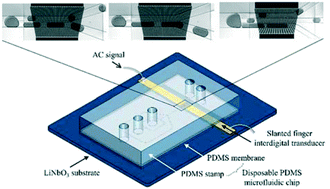Our official English website, www.x-mol.net, welcomes your feedback! (Note: you will need to create a separate account there.)
On-demand acoustic droplet splitting and steering in a disposable microfluidic chip†
Lab on a Chip ( IF 6.1 ) Pub Date : 2017-11-30 00:00:00 , DOI: 10.1039/c7lc01083d Jinsoo Park 1, 2, 3, 4 , Jin Ho Jung 1, 2, 3, 4 , Kwangseok Park 1, 2, 3, 4 , Ghulam Destgeer 1, 2, 3, 4 , Husnain Ahmed 1, 2, 3, 4 , Raheel Ahmad 1, 2, 3, 4 , Hyung Jin Sung 1, 2, 3, 4
Lab on a Chip ( IF 6.1 ) Pub Date : 2017-11-30 00:00:00 , DOI: 10.1039/c7lc01083d Jinsoo Park 1, 2, 3, 4 , Jin Ho Jung 1, 2, 3, 4 , Kwangseok Park 1, 2, 3, 4 , Ghulam Destgeer 1, 2, 3, 4 , Husnain Ahmed 1, 2, 3, 4 , Raheel Ahmad 1, 2, 3, 4 , Hyung Jin Sung 1, 2, 3, 4
Affiliation

|
On-chip droplet splitting is one of the fundamental droplet-based microfluidic unit operations to control droplet volume after production and increase operational capability, flexibility, and throughput. Various droplet splitting methods have been proposed, and among them the acoustic droplet splitting method is promising because of its label-free operation without any physical or thermal damage to droplets. Previous acoustic droplet splitting methods faced several limitations: first, they employed a cross-type acoustofluidic device that precluded multichannel droplet splitting; second, they required irreversible bonding between a piezoelectric substrate and a microfluidic chip, such that the fluidic chip was not replaceable. Here, we present a parallel-type acoustofluidic device with a disposable microfluidic chip to address the limitations of previous acoustic droplet splitting devices. In the proposed device, an acoustic field is applied in the direction opposite to the flow direction to achieve multichannel droplet splitting and steering. A disposable polydimethylsiloxane microfluidic chip is employed in the developed device, thereby removing the need for permanent bonding and improving the flexibility of the droplet microfluidic device. We experimentally demonstrated on-demand acoustic droplet bi-splitting and steering with precise control over the droplet splitting ratio, and we investigated the underlying physical mechanisms of droplet splitting and steering based on Laplace pressure and ray acoustics analyses, respectively. We also demonstrated droplet tri-splitting to prove the feasibility of multichannel droplet splitting. The proposed on-demand acoustic droplet splitting device enables on-chip droplet volume control in various droplet-based microfluidic applications.
中文翻译:

一次性微流控芯片中的按需声滴分裂和操纵†
片上液滴分裂是基于液滴的微流控单元的基本操作之一,可在生产后控制液滴的体积并提高操作能力,灵活性和通量。已经提出了各种液滴分裂方法,其中声学液滴分裂方法是有希望的,因为其无标记的操作而对液滴没有任何物理或热损伤。以前的声滴分裂方法面临几个局限性:首先,他们采用了一种交叉型声流体装置,可以避免多通道液滴分裂。第二,它们需要压电基板和微流体芯片之间不可逆的结合,使得流体芯片不可更换。这里,我们提出了一种带有一次性微流控芯片的并行型声流控装置,以解决以前的声滴分裂装置的局限性。在所提出的装置中,在与流动方向相反的方向上施加声场以实现多通道液滴的分裂和操纵。在开发的装置中使用了一次性的聚二甲基硅氧烷微流体芯片,从而消除了对永久结合的需要,并提高了微滴微流体装置的柔韧性。我们通过对液滴分裂率的精确控制,通过实验证明了按需进行声滴的双向分裂和转向,并基于拉普拉斯压力和射线声学分析分别研究了液滴分裂和转向的潜在物理机制。我们还演示了液滴三分裂,以证明多通道液滴分裂的可行性。所提出的按需声学液滴分离装置能够在各种基于液滴的微流体应用中实现芯片上液滴体积的控制。
更新日期:2017-11-30
中文翻译:

一次性微流控芯片中的按需声滴分裂和操纵†
片上液滴分裂是基于液滴的微流控单元的基本操作之一,可在生产后控制液滴的体积并提高操作能力,灵活性和通量。已经提出了各种液滴分裂方法,其中声学液滴分裂方法是有希望的,因为其无标记的操作而对液滴没有任何物理或热损伤。以前的声滴分裂方法面临几个局限性:首先,他们采用了一种交叉型声流体装置,可以避免多通道液滴分裂。第二,它们需要压电基板和微流体芯片之间不可逆的结合,使得流体芯片不可更换。这里,我们提出了一种带有一次性微流控芯片的并行型声流控装置,以解决以前的声滴分裂装置的局限性。在所提出的装置中,在与流动方向相反的方向上施加声场以实现多通道液滴的分裂和操纵。在开发的装置中使用了一次性的聚二甲基硅氧烷微流体芯片,从而消除了对永久结合的需要,并提高了微滴微流体装置的柔韧性。我们通过对液滴分裂率的精确控制,通过实验证明了按需进行声滴的双向分裂和转向,并基于拉普拉斯压力和射线声学分析分别研究了液滴分裂和转向的潜在物理机制。我们还演示了液滴三分裂,以证明多通道液滴分裂的可行性。所提出的按需声学液滴分离装置能够在各种基于液滴的微流体应用中实现芯片上液滴体积的控制。



























 京公网安备 11010802027423号
京公网安备 11010802027423号